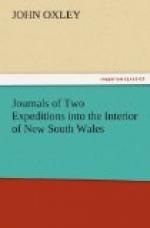The trees on the immediate banks of the river were very large and ramified, but few of them were useful: another species of callitris was seen to-day.
May 2.—Our journey this day was very fatiguing, the grass being nearly breast high, thick, and entangled. The soil is tolerably good within a mile and a half of the banks: I rode five or six miles out, in hopes of finding some eminence on which to ascend, but was disappointed, the country continuing a dead level, with extensive swamps, and barren brushes. The timber, dwarf box, and gum trees (all eucalypti), with a few cypresses and casuarinas, scattered here and there: few traces of the natives were seen, and none recent. Upon the swamps were numerous swans and other wild fowl. In the evening we caught nearly a hundred weight of fine fish.
May 3.—Proceeded down the river. We passed over a very barren desolate country, perfectly level, without even the slightest eminence, covered with dwarf box-trees and scrubby bushes; towards the latter part of the day a few small cypresses were seen. I think the other side of the river is much the same. We have hitherto met with no water except at the river, and a few shallow lagoons, which are evidently dry in summer. I do not know how far this level extends north and south, but I cannot estimate it at less than from ten to twelve miles on each side; but this is mere conjecture, since for the last three days I have been unable to see beyond a mile: I have, however, occasionally made excursions of five or six miles, and never perceived any difference in the elevation of the country. To-day the course of the river has been a little south of west: its windings are very frequent and sudden, fully accounting for the apparent heights of the floods, of which marks were observed about thirty-six feet above the level of the stream. At six o’clock the boats had not arrived; and as I had given directions on no account to attempt to proceed after dark, I ceased to expect them this evening.
May 4.—As soon as it was light I sent two men up the river to search for the boat: at nine o’clock one of them returned, having found it about four miles back. It appeared that the large boat had got stoved against a tree under water, and that the people were obliged to unload and haul her on shore to undergo some repairs, which they had effected; but the rain prevented them from paying her bottom. They expected to be able to proceed in an hour or two, as the weather had begun to clear up. It was fortunate that no damage had befallen any part of the boat’s lading. At twelve proceeded about three quarters of a mile down the river, and from a small eminence half a mile north of it, an extensive tract of clear country was seen, bearing N. 50. W., about two or three miles from us, having a low range of hills bounding them in the direction of S. 65. W. and N. 65. E. The river wound immediately under the hill, taking a westerly direction as far as I went, which was about three miles; its windings were very sudden, and its width and depth much the same as before. The country, as far as I could see, was precisely similar to that already passed over: the hills were slaty and barren, with a few small cypresses: in fact, I have seen them grow on no other spots so frequently as on those stony hills. The boats arrived about two o’clock.




